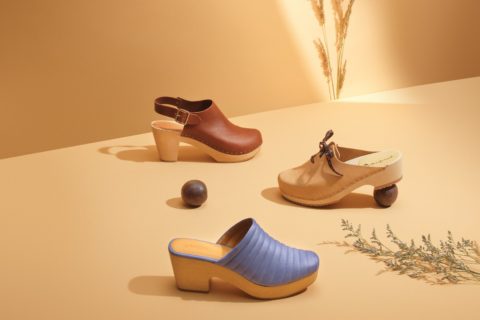The Enduring Appeal of Clog Life
How the humble wooden shoe transformed from hippie mainstay to a symbol of the aspirational leisure class
It all started with an article in The New Yorker. In January, Lauren Mechling, a former Vogue staffer, wrote a story for the magazine about embracing the new-found freedom of losing her job by acquiring a pair of No.6 clogs. The purchase of this humble wooden footwear somehow managed to soften the blow of redundancy, ushering her into a rarefied universe “littered with alpaca sweaters, Rachel Cusk novels and trees that grow indoors, in charmingly primitive ceramic pots.” In “Clog Life,” as Mechling christened it, there are no rush hours, every home has the perfect plant-to-throw-blanket ratio and women work ambiguous soft-skilled jobs that allow for plenty of leisure time. From there, the term took on a life of its own, morphing into an Instagram account (@thecloglife) run by Mechling that features celeb members of the “clogerati”—such as Sarah Jessica Parker and Gillian Jacobs—alongside enigmatic images of mid-century-inspired furniture and abstract geometric designs rendered in soft pastels. The term has also, somehow, appeared on the cover of Marie Claire Italia.
Clogs constitute a literary conception of what is fashionable. If most current trends are based on the act of appropriating an item so aggressively uncool that wearing it becomes a subversive act (think Balenciaga’s $1,265 approximation of the dad sneaker), then clogs eschew trendy in favour of lightly dowdy. With their practical low heels and rounded toes, they are a relaxation of fashion ideals, offering a boost of height without the pain of high heels while conjuring the sort of idyllic life where comfort is paramount. Clogs occupy a liminal space between the vanguard of fashion and the active renunciation of trends, and it is precisely this in-betweenness that makes them an anathema to high fashion.
The Fall 2018 season featured plenty of approximations of the clog, but it was only Dior’s student-protest-inspired cloggy slingback that objectively fit the stringent criteria of a hardy leather upper stapled to a carved wooden sole that you’ll find in Swedish Hasbeens, Svens and Troentorps. Instead, there were clog-esque sandals with thick soles at Loewe, hooflike platforms at Simone Rocha and clompy-soled boots at Aalto that conjured the heft of a clog.
Clogs represent a misshapen beauty—a sort of jolie laide, suggests Mechling. They resemble a proxy version of the aspirational Sex and the City lifestyle but updated for millennials. “For a while, Carrie Bradshaw telegraphed a whole world that everyone understood,” she says. Clogs, in all their lumpen beauty, have replaced Carrie’s Manolo Blahniks as a current status symbol because they suggest a patina of wealth that allows the wearer to exist in a bubble of total comfort.
Clogs have always been a fringe item that is never quite in or out of style, but their rise meshes well with our culture’s current feverish obsession with wellness. Reportedly a $3.7 trillion global industry in 2015, wellness has shed its hairy-legged, health-food-store reputation—of which clogs are very much a part—in favour of hard-bodied yogis who take a month-long vow of silence at a meditation retreat…and then post about it on Instagram. Now, the imperative to engage in “self-care”—an obnoxiously ambiguous term that can mean anything from painting one’s nails to booking a trip to Bali—has become an indicator of self-worth. Ironically enough, clogs now symbolize both a rejection of orthodoxy and an adherence to it.
Kim France, founding editor of Lucky magazine and OG clog proselytizer, suggests that over the past six or seven years, clogs have shifted from a trend-based item to a perennial classic. Conspicuously, this shift mirrors the growth of the freelance economy, where workers are no longer tethered to the nine-to-five grind. By 2020, an anticipated 45 per cent of Canadians will be self-employed, many of whom will presumably work from home, coffee shops or co-working spaces rather than in the confines of an office. “Clogs are a terminally casual shoe,” says France. “They symbolize life outside of an office and getting to dress the way I want and not the way I’m supposed to.”
Maestro of stilettos Christian Louboutin once said: “I hate the whole concept of the clog. I just picture a woman feeling bad, with a big bottle of alcohol, really puffy. It’s really depressing, but she likes her life because she has comfortable clogs.”
Thanks to Clog Life, these widely reviled wooden shoes represent a new form of beauty and are rising up to take their rightful place in many women’s wardrobes—most likely in that coveted spot by the front door where shoes that can be easily kicked on and off are kept. As a clog fan, I can barely muster any affront at Louboutin’s conspicuous clog hatred. In my black Mary Jane-style Lotta from Stockholms, I’m simply too comfortable to care.








